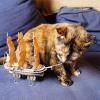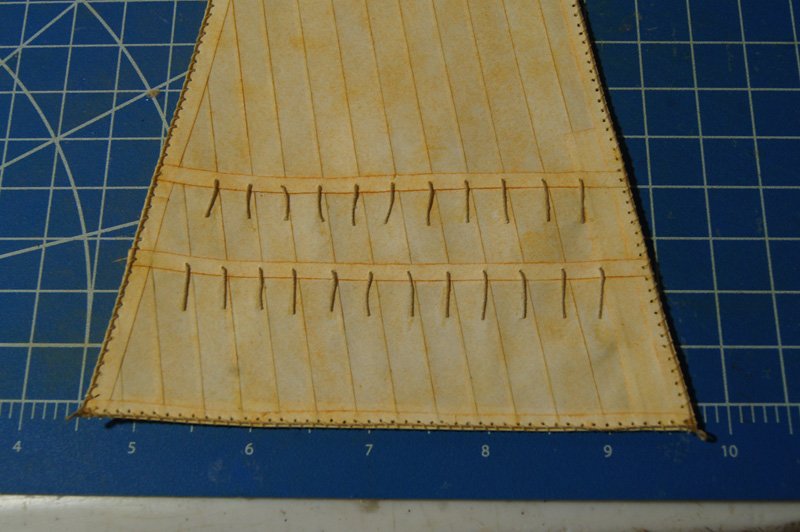-
Posts
3,487 -
Joined
-
Last visited
Content Type
Profiles
Forums
Gallery
Events
Everything posted by Cathead
-
As discussed in that thread, I used bond paper, which is a high-end paper used for printing that needs to last. Specifically, I used supplies left over from my wife's graduate thesis 20 years ago, still in perfect shape. It should last as long as any model that isn't museum-grade does.
- 35 replies
-
- Constitution
- Revell
-
(and 1 more)
Tagged with:
-
Glad to find this log, I think your approach is excellent: recognizing the kit isn't perfect and not presenting it as accurate, but also having fun with a build and learning from it rather than getting bogged down or despairing. My first models are laughable to me now but I enjoyed them and learned so much! As for sails, at risk of self-promotion, here's a method I developed for making paper sails that I find very effective and attractive. There are various other ideas in the sails section of MSW. Following are two examples from my revenue cutter project.
- 35 replies
-
- Constitution
- Revell
-
(and 1 more)
Tagged with:
-
Another point here in case it helps clarify your situation: hull planking will almost always require either edge bending or spiling because the planking will curve through three dimensions. Most kits provide only straight stock that isn't wide enough for spiling, meaning that you have to edge-bend to use kit stock, but most such kits never explain this and it can give newer builders fits. Unless you buy a rare kit whose planking is pre-spiled, you either edge-bend the kit stock or buy sheets of wood that you can cut your own spiled planking out of, discarding the kit stock.
-
Looks like a neat project. I'm not familiar with this source, so what a great chance to learn about their kits!
- 84 replies
-
- Statenjacht
- Kolderstok
-
(and 1 more)
Tagged with:
-
Beautiful, and thanks for the detailed instructions from the beginning. Helps folks like me learn.
-
Wooden ship building definitely has a steep learning curve. You're doing great and you'll be proud to display this when you're done. And yes, I think you'll love building a new project with good materials and instructions!
- 89 replies
-
- Enterprise
- first build
-
(and 2 more)
Tagged with:
-
Welcome back! I hesitate to note this, but will do so in case you care: several of the deadeyes are rigged incorrectly. They should always be rigged so that the top hole in the triangle of three holes faces away from the other deadeye, like this (from this great page on rigging by the San Diego Ship Modeler's Guild😞 Of the four you show, the second from the left is correct, the rest are not. Now, you don't have to fix this; the vast majority of viewers won't notice or care and the model will look great regardless. I just mention it because a lot of modelers enjoy learning as part of the building process, and if this level of accuracy is important to you, it's easier to correct it now as you've only done 4! But you have every right to shrug and move on; we all draw the line somewhere. EDIT: Oops, apparently you posted your update as I was writing the above. Adding all the ratlines does change the equation on redoing the deadeyes. It's still up to you, as they're technically independent from the shrouds. But you can always apply the "correct" method to the other mast and just not worry about this obscure detail.
- 89 replies
-
- Enterprise
- first build
-
(and 2 more)
Tagged with:
-
Here's a thread (no pun intended) from the MSW rigging section that contains a variety of suggestions, examples, and links for methods:
- 96 replies
-
- topsail schooner
- revenue cutter
-
(and 3 more)
Tagged with:
-
If I understand your question correctly, I did that in two ways depending on context: (1) by passing the line through the bolt or block, tying the simplest possible overhand knot to hold it in place (think the first step of shoelace tying), using a small clamp to hold both ends of the line parallel, applying a tiny drop of glue to fix the proto-knot in place, then finishing the knot or wrapping the loose end around the taut end as needed. (2) by doing something similar, but to simulate "serving" (the finer line wrapped around two rope ends to hold them in place), once I used a drop of glue to hold the original rope in place, I simply used fine tweezers to wrap finer line around just like real serving, again using a spot of glue to hold it in place once done. If these written descriptions aren't clear, I can try and whip up a mock photo or two for you.
- 96 replies
-
- topsail schooner
- revenue cutter
-
(and 3 more)
Tagged with:
-
Well, if you have questions, you can always send me a direct private message through MSW's system. To do this, click on a member's name to go to their profile, then hit the prominent "message" button right next to "follow member".
- 96 replies
-
- topsail schooner
- revenue cutter
-
(and 3 more)
Tagged with:
-

Ancient anchor found in Yucatan.
Cathead replied to Eugenio Treviño's topic in Nautical/Naval History
I could easily imagine it being a storm-driven wreck. Even if it happened post-settlement, hurricanes can move incredible amounts of sediment, easily covering a large anchor before anyone had the chance to salvage it. -

Ancient anchor found in Yucatan.
Cathead replied to Eugenio Treviño's topic in Nautical/Naval History
Not necessarily. Shorelines change naturally all the time, especially if there's a river mouth nearby dumping sediment into the area. Waterfronts also routinely get filled in by humans to make more usable land. For example, a significant amount of downtown Boston is built on fill and its modern shoreline would be nearly unrecognizable to 18th century residents. So it's pretty easy to imagine the anchor being lost in a harbor area 200 years ago that has since filled in. Reading the Spanish account, this was found along a seafront promenade, so a variety of scenarios are possible, from it being dropped in an area that's since filled in (naturally or anthropogenically), to it being washed ashore and buried by a long-ago hurricane (to which the Yucatan is prone), to even theoretically being abandoned on land as naval stores and buried. -
This is a great attitude! I'm so glad you're sticking with the project despite the kit's myriad flaws. If you're finding this worthwhile, you have a bright future ahead building kits from better sources! Do you have a build log? If so, I'd be happy to follow along and offer advice if needed.
- 96 replies
-
- topsail schooner
- revenue cutter
-
(and 3 more)
Tagged with:
-
I personally think railings are the worst part of steamboat modeling.
- 238 replies
-
- Robert E Lee
- steamboat
- (and 3 more)
-
Thanks Brian and others. I won't be doing any projects for quite a while, I injured my wrist and need surgery with a 1-2 month recovery time. Has rearranged our whole life.
-
That's wonderful! Not sure what to tell you about the album question, I've never had that problem. Can you be more specific about what's not working?
-
Thanks, Tommy! I'm glad to hear it. Sounds like you're pretty far along, but if you'd like to start a build log anyway and I'd be happy to follow along as you finish it off.
- 96 replies
-
- topsail schooner
- revenue cutter
-
(and 3 more)
Tagged with:
About us
Modelshipworld - Advancing Ship Modeling through Research
SSL Secured
Your security is important for us so this Website is SSL-Secured
NRG Mailing Address
Nautical Research Guild
237 South Lincoln Street
Westmont IL, 60559-1917
Model Ship World ® and the MSW logo are Registered Trademarks, and belong to the Nautical Research Guild (United States Patent and Trademark Office: No. 6,929,264 & No. 6,929,274, registered Dec. 20, 2022)
Helpful Links
About the NRG
If you enjoy building ship models that are historically accurate as well as beautiful, then The Nautical Research Guild (NRG) is just right for you.
The Guild is a non-profit educational organization whose mission is to “Advance Ship Modeling Through Research”. We provide support to our members in their efforts to raise the quality of their model ships.
The Nautical Research Guild has published our world-renowned quarterly magazine, The Nautical Research Journal, since 1955. The pages of the Journal are full of articles by accomplished ship modelers who show you how they create those exquisite details on their models, and by maritime historians who show you the correct details to build. The Journal is available in both print and digital editions. Go to the NRG web site (www.thenrg.org) to download a complimentary digital copy of the Journal. The NRG also publishes plan sets, books and compilations of back issues of the Journal and the former Ships in Scale and Model Ship Builder magazines.








